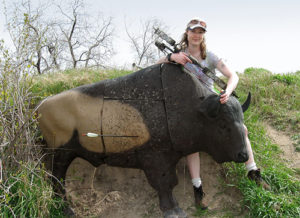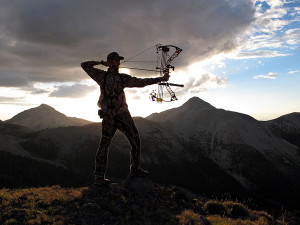Preparing for the Hunt at the 3D Archery Range
With the Utah archery hunt just weeks away, it’s time to get serious about pre-hunt preparation. Over the years we’ve discussed several ways to prepare for the hunt; things like exercise, scouting, mediation, and shot execution. But nothing gets you ready for real-life hunting like the 3D archery range.
What is a 3D range?
A 3D range is simply a series of life-size, foam animal targets set up in a natural environment. The targets are roughly the same size and shape as real animals. Just like regular square targets, 3D targets have a series of concentric circles overlaying the vitals, but are nearly impossible to see at any distance. This aids in proper shot placement while allowing you to score your shot.

Russell and his son harvest some foam.
How is a 3D range beneficial?
How is it NOT!? A good outdoor range is set up in a life-like manner so that some shots are uphill or downhill, through brush and trees, and at various random yardages. Add to that odd angles, wind, bugs buzzing around your head, uneven terrain, sun in your eyes, back lit targets, and sweltering heat…well it’s a recipe for a real-life hunting experience! And that’s why it’s so crucial to try the 3D range at least once before the hunting season begins. It’s also a ton of fun for everyone.

What can I expect to learn at the 3D range?
Right away you might be disappointed by your lack of shooting skills; and that’s the point. Most people start the summer by shooting on flat ground at square targets with bright bullseyes. That might be fine for sighting in your bow, but over time it does more harm than good. That’s because you’re training your mind to shoot under very predictable conditions.
The 3D range–on the other hand–mimics adverse conditions that you will certainly find in the woods, and therefore trains your mind to expect the unexpected, a skill that’ll prove invaluable afield.

How can I maximize my 3D experience?
The most effective way I’ve found to maximize your 3D experienc e is to shoot two arrows per target. The first arrow should be shot by estimating the distance without a rangefinder. The second arrow is shot after verifying the distance with a rangefinder. This method really helps rain your eye to judge distances for situations where there’s no time to range the animal before the shot.
You should also shoot from various body positions like standing, kneeling, or even squatting to keep your arrow from hitting an overhanging branch.
For the best possible experience, hit the range with a buddy or two, and be sure to keep score. After teaching archery for four years, I’ve found the best way to tighten up an arrow grouping is to engage in a little competition. Pride might be enough to ignite a fierce competition, but toss a few bucks in and watch the competition soar.

Conclusion
No matter what city you live in, there’s likely a 3D range nearby. If you don’t have access to a range, you can always purchase a few 3D targets from any outdoor retailer. 3D targets are quite expensive, but having one or two on hand will prove invaluable for your hunting skills.
I suggest visiting a few different ranges, and then concentrate on the most challenging one. For best results bring some friends and really push yourself. Shooting the 3D range is the most effective way I’ve found to improve shooting skills before entering the woods.


